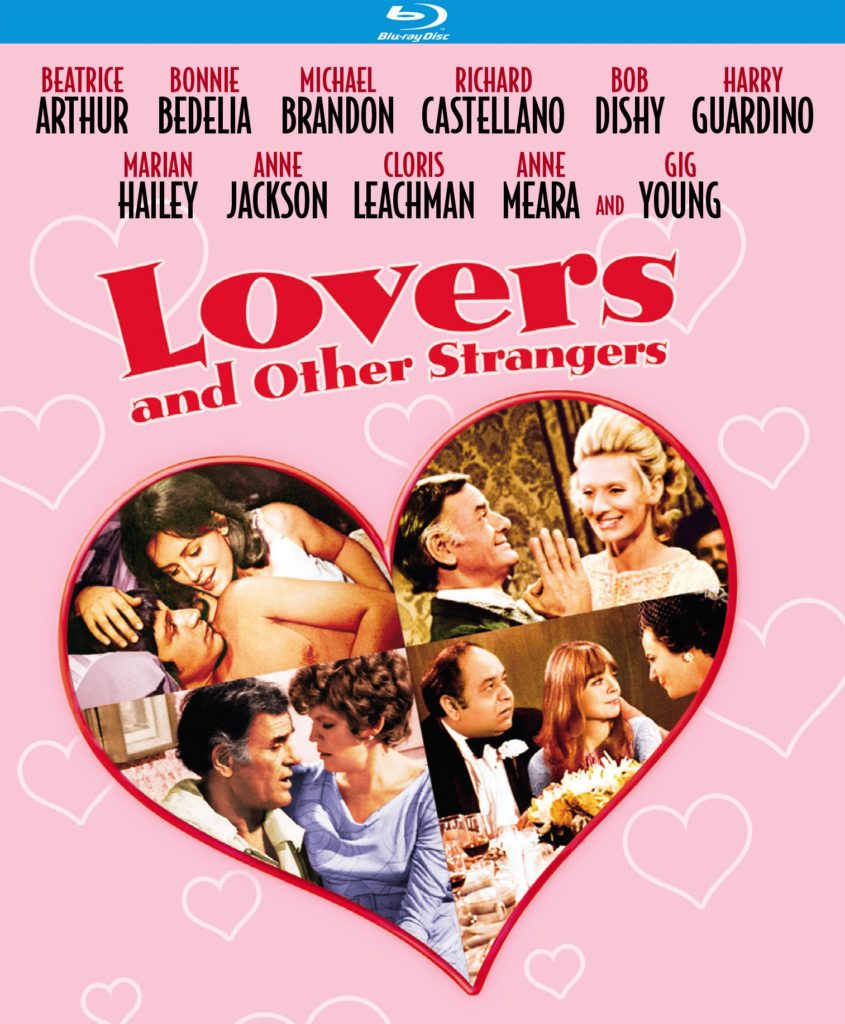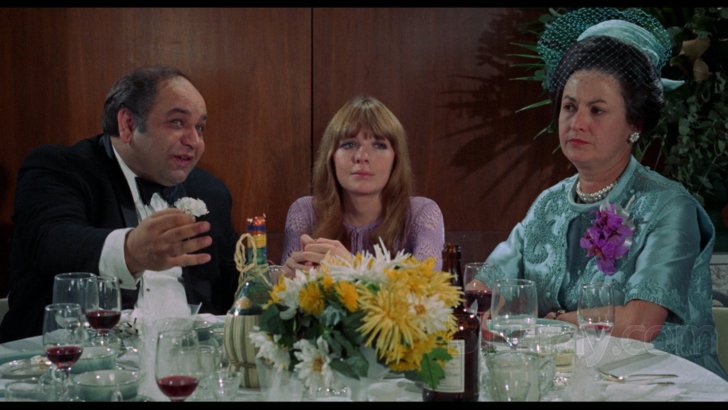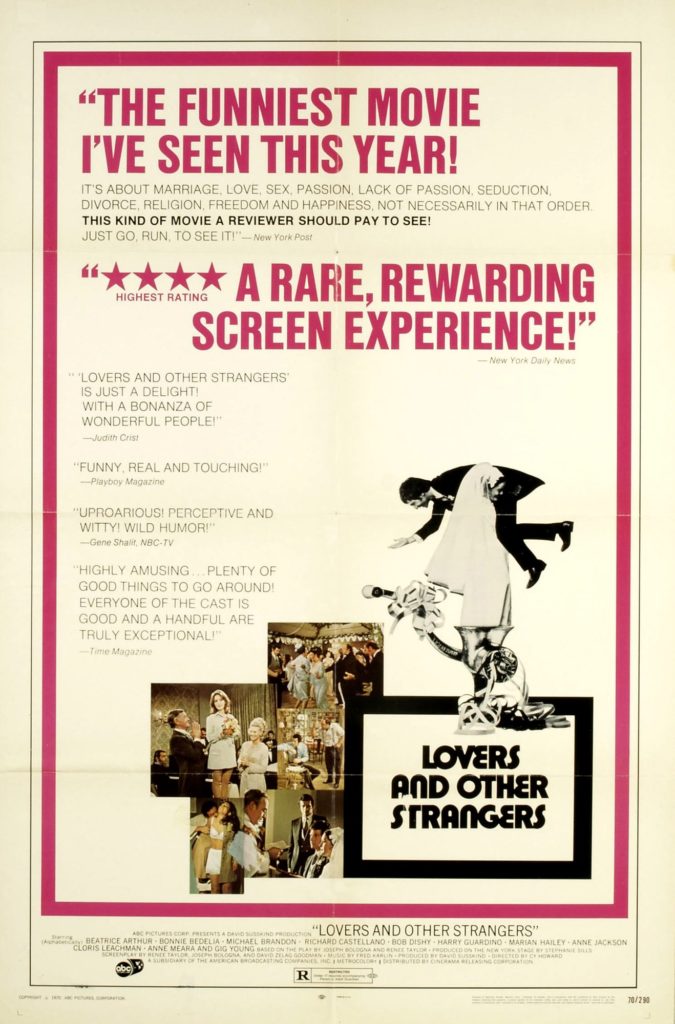Life, Family, Marriage, Love And Other Familiar Strangers

DIRECTED BY CY HOWARD
STREET DATE: March 19th, 2019/KINO LORBER STUDIO CLASSICS
Wife-and-husband playwrights Renée Taylor and Joseph Bologna brought their debut Lovers and Other Strangers to Broadway in the fall of 1968, where it closed later that fall after a scant seventy performances. The multi-character portrait of a hastily assembled, raucously incompatible ceremony, uniting a working-class clan on the groom’s side with an upper-middle-class family on the bride’s, nevertheless attracted the attention of television producer David Susskind, who saw its potential for the big screen despite its abbreviated theatrical run. With its brilliant cast of familiar and soon-to-be recognizable performers — including Cloris Leachman, Bonnie Bedelia, Anne Meara, Anne Jackson, Richard (S.) Castellano, Gig Young, Harry Guardino, (a debuting) Diane Keaton, and (a near-debuting) Bea(trice) Arthur — this New York City-shot independent production became the sleeper hit of 1970 and was nominated for two Academy Awards (for actor Castellano with writers Bologna and Taylor, the latter pair shared with co-screenplay adaptor David Zelag Goodman) and the winner of one (for the Fred Karlin song “For All We Know”).

Upon its release, the film of Lovers and Other Strangers proved an uncommon comedy-dramatization of well-worn romantic themes, with recognizable and soon-to-be familiar actors bringing a then-startling degree of honesty and frankness to the pluralistically-paired plotting(s) of love, marriage, and other un(der)known quantities. Centered around the lead-up to and aftermath of a younger, Italian-American son’s (Michael Brandon) union with a younger, WASP daughter (Bonnie Bedelia), despite the mutual parental-deception of having lived together the past year as gender-appropriate “roommates”, other realistically-strained romantic strains include un-model marriages such as the high-volume voice and physical presences of the groom’s parents’ (Arthur and Castellano) and the passive-agressive nature of their oldest son’s (Joseph Hindey) against the emotionally-distant bride’s parents’ (Leachman and Young) and their tension-fraught oldest daughter’s (Anne Meara).
Between these imperfect models, the father of the bride (Young) is having an uneasy affair, seeming to take place mainly in mirrored bathrooms(!), with his wife’s best friend (Anne Jackson), while the groom’s best friend (Bob Dishy) and best friend of the bride (Marian Hailey) are commencing their own equally uneasy, post-sex revolution courtship in dimly-lit bars, gas-leaking one-rooms, and across hotel hallways. Vignette-building to and -falling away from the young couple’s nuptials, who have several reservations of their own beneath the montage soft-glow of a dark beige and bright yellow ceremony, the multiple dramatically-comedic pairings resolve to a cast-call of perfectly-imperfect and lifelike-realistic romantic ambiguities.
As observed by audio commentator Lee Gambin on Kino Lorber’s new Blu-ray, the social and historical shift in dramaturgy, from the experimental 1960’s to the realism of the 1970’s, is well-represented in Lovers and Other Strangers, where a concurrent hit such as William Friedkin’s 1970 film of Mart Crowley’s The Boys in the Band, which had also debuted as a play in 1968, gained similar impact from a new level of screen intimacy and affectingly deeper levels of characterization. An argument over an urban, ethnic family’s dining room table is drawn with as much resonant realism as a suburban BBQ-poolside chat about premarital sex, and similar topics of infidelity, commitment, and lust are held in equal balance, given the play’s comically dramatic (or dramatically comic) structure, to the central topics of love and marriage. The parallel-shot scene between Bea Vecchio (Arthur) and her (possibly soon-to-be-ex-)daughter-in-law (Diane Keaton) alongside father (Castellano) and son’s discussion of the thirty-year Vecchio marriage’s fundamental incompatibility may suggest how a life union in 1970 may be doomed from the get-go, and perhaps may always have and always will be, but Lovers and Other Strangers’ complexity in portrayal emphasizes the joy and pain, equally, in the valiant attempt. (As an interesting parenthetical, it might be noted that co-playwrights’ Bologna and Taylor’s 1965 marriage, upon which the wedding lead-up, ceremony, and reception was based, lasted until Joseph Bologna’s recent passing in 2017.)
Given its rich, urban flavor, along with its incredible roster of actors, it is unsurprising that Lovers and Other Strangers proved a venerable (if in latter days underseen) property, especially on the small screen. Playing like some long-lost episode of subsequently familiar and equally frank “social issue” TV sitcoms of the 1970’s such as All in the Family or Maude — both of which set a standard for one act-like comedy-dramas of that decade, mixing pathos and hilarity in equal measure to brilliant actors who enacted strongly-written characters — Lovers and Other Strangers realistically drew the curtain from a majority of viewers and audience members’ lives to the stage and screen first. Having over the past few years gone over each episode of those sitcoms in some viewing detail, along with The Mary Tyler Moore Show, The Bob Newhart Show, Rhoda, Phyllis, Barney Miller, Lou Grant, among others, the formidable presence of a Bea Arthur, Cloris Leachman, or Anne Meara brings a viewer in 2019 to the unmistakable depth and detail of comic-dramatic episodes truly drawn from life.

An actor’s as well as a viewer’s feast, this 104-minute melding of comedy and drama, sex and marriage, along with stage and screen, arrives on the perfect viewing format of Kino Lorber’s grain- and grit-preserved, film-theatrical presentation on Blu-ray. The mentioned Lee Gambin commentary draws all these elements glossed over in this review in much greater depth, making connections in live performance and media both leading up to and following Lovers and Other Strangers’ filmed-theatrical run (not unlike the comic-dramatic structure of the play-story, come to think of it) in an engaging and conversational manner (not unlike the multi-faceted style of performance of the film itself, come to further think of it). In this light, and given Mr. Gambin’s previous commentaries for Kino Lorber on screen fare as diverse as the 1984 American farm drama Country, the 1939 Hollywood screwball dramedy Made for Each Other (unrelated to the 1971 Taylor & Bologna co-written and -starring follow-up to LaOS, although curiously complementary), and the 1971 off-road trip Kotch, Lovers and Other Strangers gives viewers a Bologna & Taylor-made chance to see social history — joys, warts, and all — effectively reflected by (and, more importantly, reflective of) the emotional core of its artistic milieu. Committed appreciators of characters, actors, comedy, drama, and all the familiar strangers in between, are strongly referred to the universal qualities drawn from this circa 1970, New York City theatrical look at life, love, and marriage.
The images used in this review are provided only as a visual reference to the film and are not meant to reflect the image quality of Kino Lorber’s Blu-ray.

